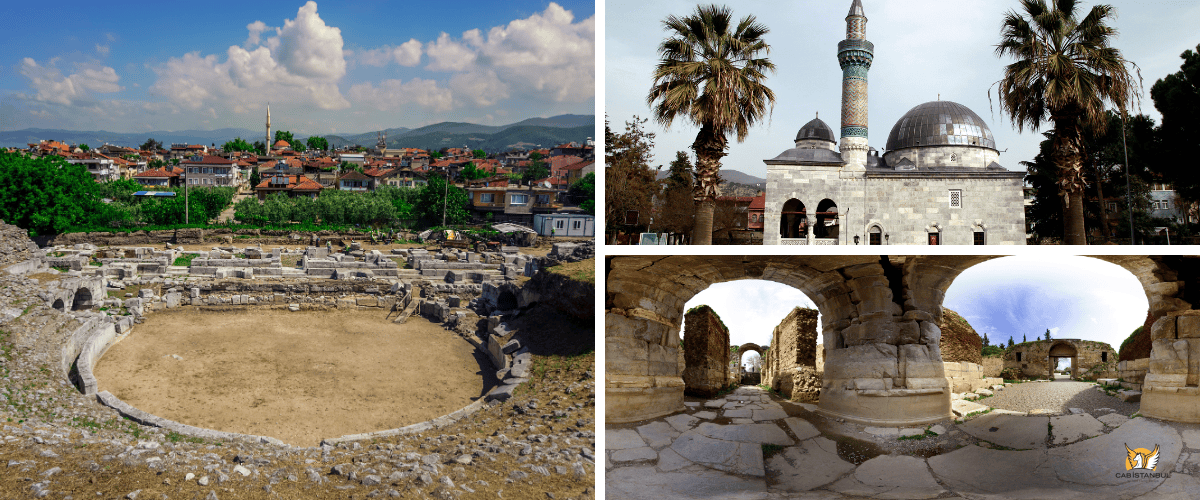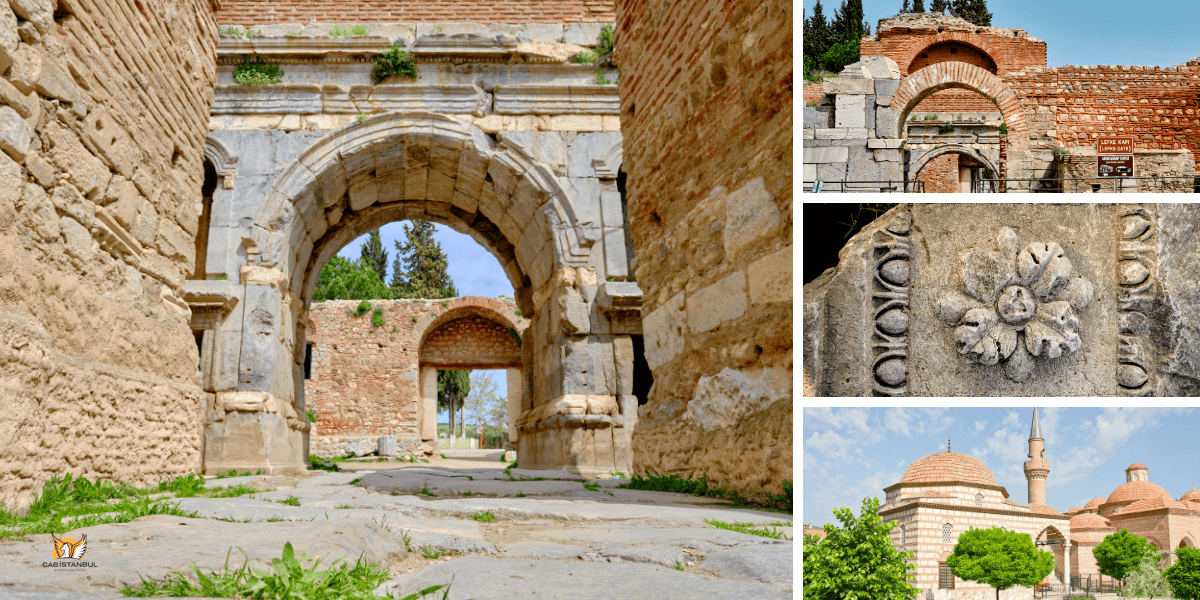Council of Nicaea
2025-12-26

Nicaea / Iznik
Iznik, historically known as Nicaea, stands as one of the most influential cities in the history of early Christianity, culture, and Anatolian civilization. Nestled along the serene shores of Lake Iznik in the province of Bursa, this ancient settlement offers an immersive blend of archaeological depth and natural tranquility. Renowned as the gathering place of the First Council of Nicaea in AD 325, the city became the birthplace of the Nicene Creed, shaping the spiritual foundations of the Christian world. This unique heritage is the reason why Pope Leo XIV will begin his first international visit here on 27 November 2025, drawing global attention once again to Iznik’s sacred legacy.
As you wander through the city, the layered history of Roman, Byzantine, Seljuk, and Ottoman eras unfolds effortlessly. The iconic Hagia Sophia of Iznik, once a Byzantine basilica and later an Ottoman-era mosque, stands as the symbolic heart of the council’s memory. Nearby, the vast Roman Theater, monumental city walls, grand gates, and archaeological remnants offer a vivid journey into Iznik’s strategic and religious importance. Each site reveals a chapter of theological debates, imperial gatherings, artistic breakthroughs, and architectural mastery.
Beyond its historical significance, Iznik is world-famous for its exquisite Iznik pottery and Ottoman ceramics, admired for their vibrant cobalt blues, elegant patterns, and unmatched craftsmanship. Local workshops continue this centuries-old tradition, making the town a living museum of artisanal heritage.
Whether you explore its ancient avenues, lakeside promenades, or sacred landmarks, Nicaea / Iznik invites you to experience a rare harmony of faith, culture, and timeless beauty. Here, every stone, inscription, and artifact carries the echoes of a civilization that shaped world history.
Experience Iznik with ease—our Istanbul-Iznik transfer and chauffeur-driven car rental services offer safe, comfortable travel from Istanbul to Iznik or any destination in Türkiye. Book with Cab Istanbul for a seamless journey tailored to your needs.
Hagia Sophia Iznik
Council of Nicaea
The First Council of Nicaea, convened in 325 AD by Emperor Constantine I in ancient Nicaea (modern-day İznik, Turkey), stands as the inaugural ecumenical council of the Christian Church. Its primary purpose was to address the growing doctrinal conflict sparked by Arianism. This controversial teaching, advocated by Arius of Alexandria, argued that Christ was not fully divine but a created being. Constantine—still an unbaptized catechumen—presided over the opening session, emphasizing his desire to secure unity within the Christian world.
A defining outcome of the council was the condemnation of Arianism and the formulation of the Nicene Creed. To affirm the full divinity of Christ, the council adopted the term homoousios (“of one substance”), declaring that the Son is eternally equal with the Father. Though met with resistance by some bishops, this doctrinal statement became a foundational element of Christian orthodoxy. Arius himself was exiled, marking the strengthening alliance between imperial authority and ecclesiastical leadership.
Beyond theology, the council established influential ecclesiastical and administrative decrees:
Date of Easter: Efforts were made to standardize the celebration, though full consensus was not reached.
Clerical Conduct: The council outlined norms for bishop consecration, forbade clergy from lending money at interest, and restricted movement between churches.
Primacy of Sees: The sees of Alexandria and Jerusalem were formally recognized for their regional authority.
According to the historian Socrates Scholasticus, the Council also debated clerical celibacy but ultimately abandoned strict mandates due to considerable opposition.
The legacy of the First Council of Nicaea is profound. It not only clarified essential Christian doctrine but also established a new model for collaboration between Church and empire, shaping the theological and organizational foundations of Christianity for centuries to come
Birthplace of Christian Doctrine
İznik is the site where the Nicene Creed—the foundational profession of faith for Catholics, Orthodox, and most Protestant traditions—was shaped. For the new Pope, returning to the origins of Christian orthodoxy is a gesture of renewal and reconciliation.
1700th Anniversary Significance: His visit coincides with the commemorations surrounding the 1700-year legacy of the council. This anniversary has reignited global interest in the historical and spiritual heritage of Nicaea.
Symbol of Unity: The Pope aims to highlight the council’s message of unity at a time when dialogue between Christian denominations is of growing importance.
Iznik Ancient City
Hagia Sophia of Nicaea
Perched upon the foundations of a Roman Gymnasium, the Hagia Sophia of Nicaea stands as a testament to the city's architectural evolution through the ages. Originally erected as a basilica during the Byzantine era in the 7th century, the structure witnessed a significant renovation post a calamitous earthquake in the 11th century.
- The edifice's initial architectural grandeur is believed to have spanned from the 4th to the 5th centuries, boasting a basilica design with brick walls atop stone foundations. The remnants of this period exhibit thick mortar layers and coarse brickwork, encapsulating the architectural prowess of the Roman age.
- Following the destruction wrought by the earthquake of 1065, the Hagia Sophia underwent a meticulous restoration. The floor was elevated by 1.40 meters, the outer walls were fortified, and a new layout featuring a three-naved naos (sanctuary) emerged, with the side naves seamlessly blending into the central nave through an elegant arrangement of arches and piers.
- The epoch of Orhan Gazi in 1331 marked a new chapter for the Hagia Sophia as Iznik fell under the dominion of Bursa. The edifice saw another elevation, with alterations to the nave separations, and a transformation into a mosque adorned with a minaret and mihrab. The remnants of today's minaret, along with several architectural modifications, bear the hallmark of Mimar Sinan's craftsmanship, reflecting the Turkish Period's influence on the Hagia Sophia.
As the heart of Nicaea continues to beat through its ancient walls and timeless relics, the city invites all to delve into a narrative rich with historical and architectural splendors. Each stone and mosaic within the Hagia Sophia narrates tales of empires risen and fallen, rendering Nicaea a must-visit haven for those entranced by the allure of the past.
Nicaea Museum
Nicaea Museum found its inception in 1960 within a structure honoring Nilufer Hatun, the consort of Orhangazi, the second sultan of the Ottoman Empire. Initially serving diverse purposes and functioning as a hotel in 1388, this edifice epitomizes Ottoman architectural brilliance. Today, the museum showcases archaeological treasures unearthed from nearby excavations, with a garden replete with monuments echoing the Roman, Byzantine, and Ottoman legacies.
Nicaea Castle
Nicaea Castle dates back to 258 BC, with roots entrenched in the Roman era. The castle, with its myriad gates including the Istanbul gate, and 12 secondary entrances, stands resilient through time, courtesy of bastion reinforcements. Each gate, named Yenisehir (new city), Lefke, and Gol (lake) among others, invites visitors to step back into antiquity.
Bursa Old City-Nicaea

İznik Historical Places
The Nicaea Ancient City invites you to traverse the alleys of time, unveiling tales of empires that once reigned. The Nicaea Museum, nestled amidst the enduring whispers of the past, curates a rich tapestry of artifacts, each a silent narrator of the Roman, Byzantine, and Ottoman epochs. Towering with a tale of resilience, the Nicaea Castle stands as a monumental testimony to the indelible imprints of time. İznik-Nicaea is not merely a visit, but an immersive voyage through the rich chronicles of history.
Nicaea Ancient City
Ancient City nestled within the district of Iznik in Bursa province, the Nicaea Ancient City boasts a rich tapestry of history dating back to its early foundations. Once hailed as the capital of the Kingdom of Bithynia, the city later morphed into a vital hub during the Roman era. Following a destruction in the 4th century BC, it was rejuvenated by a commander allied with Alexander, and now houses an ancient theater among other significant ruins, each narrating tales of varying historical epochs and societal events etched onto the stone.
Gate of İstanbul-Nicaea
The Gate of İstanbul-Nicaea, located in Bursa's Nicaea district, is a relic dating back to the 4th century BC, encompassing three distinct sections. A silent witness to the ebb and flow of numerous civilizations, the gate's walls narrate tales of historical defenses and soldier valor, etched in the form of detailed graphics, making it a living chronicle of the region's vibrant past.,
Green Mosque İznik (Yeşil Cami)
In the heart of Nicaea, Bursa, lies the Green Mosque İznik (Yeşil Cami), a hallmark of early Ottoman architectural splendor. Commissioned by Halil Hayrettin Pasha from Candarli and brought to life by architect Haci Mustafa, this mosque, known for its unique minaret tile decorations, stands as a testament to the artistic evolution during the early Ottoman era, having undergone restorations post the Greek occupation of Nicaea and serving the community since the early days of the republic.
Nicaea Turkey Attractions
Things To Do In Iznik
Delve into the serene and historical heart of Iznik, where architectural marvel and natural beauty intertwine. The iconic Green Mosque unveils early Ottoman architectural finesse, enveloped in a unique tapestry of verdant tile work. Venture into the depths of Sansarak Canyon, a haven for adventurers and nature lovers, offering scenic trails and a glimpse of rustic village life. Immerse in the soothing embrace of Keramet Thermal Springs, a realm of healing and relaxation renowned for its therapeutic waters. Lastly, the placid shores of Nicaea Lake invite a moment of reflection amidst a picturesque setting, offering a tranquil retreat from the hustle of urban life. Each corner of Iznik narrates a story of nature's tranquility and historical grandeur, waiting to be explored.
İznik Lake
Gracing the districts of Orhangazi and Iznik, Iznik Lake, previously known as Askania, holds the title of the fifth largest lake in Turkey and the grandest in the Marmara Region. Spanning 298 km² and situated 85 m above sea level, the lake harbors a variety of fish including levrek, yellow carp, and silverfish, alongside being a hub for water sports enthusiasts. The Izzet Pasha Water Sports Facility, Çakırca Village Beach, and the underwater basilica locale offer diverse recreational options to visitors.
Keramet Thermal Springs
Keramet Thermal Springs, named after the revered Father Keramet (Miracle), are famed for their therapeutic waters. Drawing numerous health and relaxation seekers, especially during the chilly winters, the springs offer a haven of healing amidst the serene Nicaea backdrop.
Sansarak Canyon
The Sansarak Canyon, nestled in the Nicaea district, stands as a magnet for nature enthusiasts and adventurers. With weekends often bustling with campers, the canyon offers one of Turkey's most challenging hiking trails, besides the quaint charm of Ottoman village homes and delightful village breakfasts awaiting visitors in Sansarak.
Iznik Lake
Iznik Tiles Turkey
İznik tiles are globally celebrated for their intricate craftsmanship and vibrant aesthetics. These tiles are made on a pristine white base with hard backs and underglazed decorations, comprising 70-80% quartz and quartzite. This unique composition combines quartz, clay, and glaze, fired at 900°C, creating tiles that are durable and visually captivating. The porous structure of the tiles allows them to "breathe," adapting to temperature changes while maintaining their integrity.
The colors of İznik tiles are inspired by semi-precious stones, such as lapis lazuli's deep blue, turquoise's soft blue, coral's red, and emerald's green. Achieving these vivid hues, especially coral red, requires exceptional skill and opaque glaze that enhances their brilliance while reducing light strain on the eyes. The slightly opaque sheen also protects the tiles over time.
İznik tiles feature designs reflecting the flora, fauna, and cultural symbols of their region, with geometric patterns often carrying cosmological meanings. These timeless motifs blend harmoniously with their architectural surroundings, offering understated elegance. Inscriptions on the tiles convey the ideology of Islam, emphasizing spirituality and moderation.
To preserve authenticity, the İznik Foundation continues to use 16th-century techniques and raw materials, ensuring the legacy of this art form endures. Whether adorning mosques or palaces, İznik tiles remain a symbol of cultural sophistication and artistic excellence.

Write a Comment !